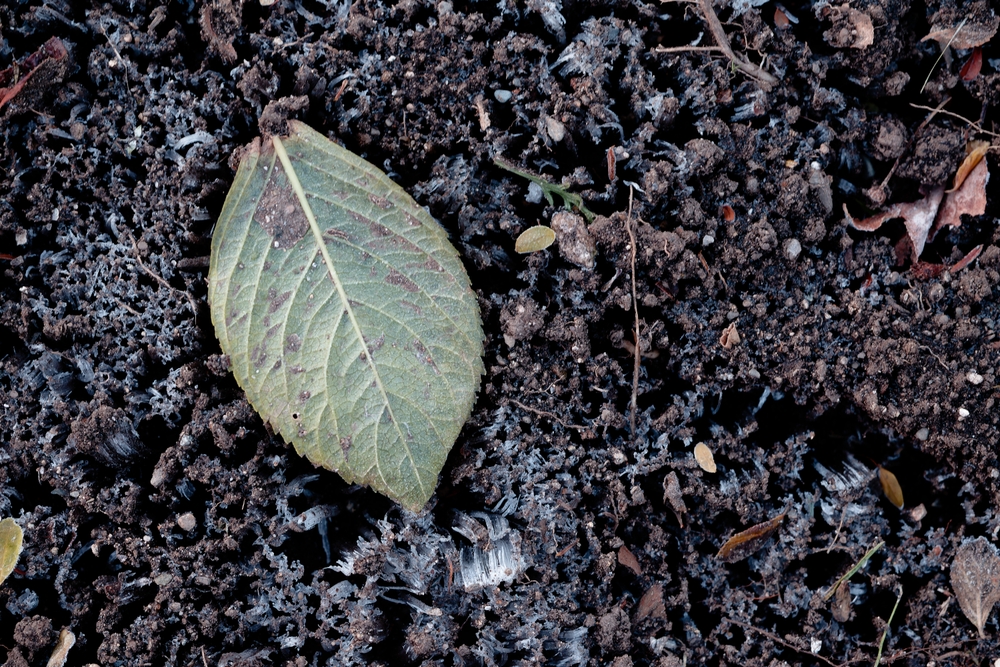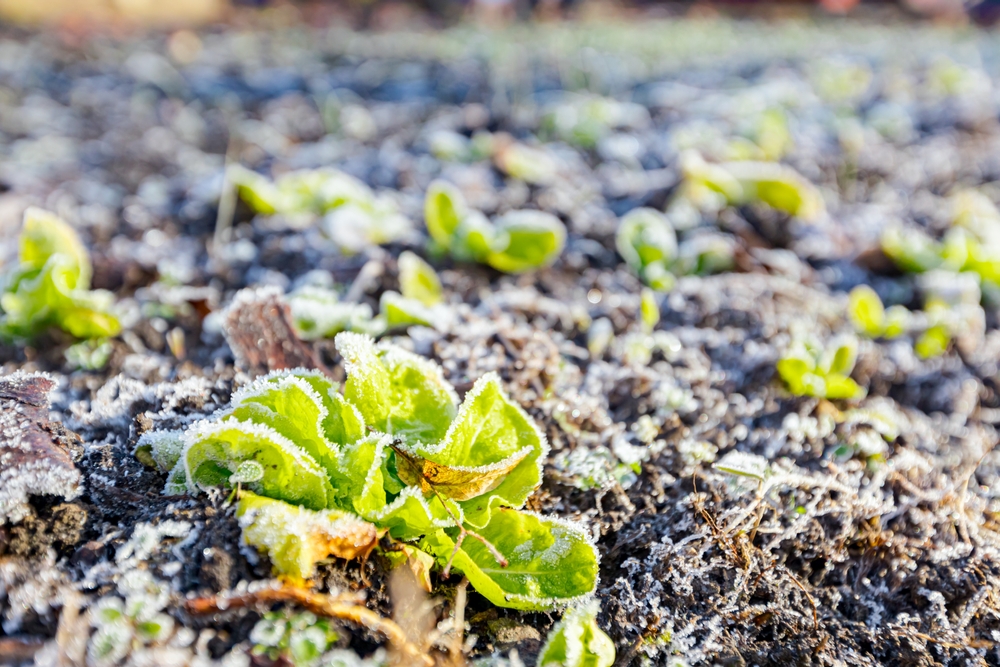
Image Source: Shutterstock.com
There’s something almost magical about that first frost. The air gets crisp, the leaves crunch underfoot, and the landscape glitters like it’s been dusted with diamonds. But beneath that shimmering surface, an invisible drama is unfolding—one that determines how your garden, lawn, or farm will perform come spring.
The first frost isn’t just a temperature drop—it’s a biological reset button for the soil. Microbes panic, worms retreat, and nutrients begin a quiet game of musical chairs, all working together in nature’s version of winter prep.
When the Chill Hits: Microbes in Mayhem
The moment temperatures plunge below freezing, soil microbes face a harsh reality check. Bacteria and fungi that thrive in warm, moist conditions suddenly find themselves battling icy barriers and dwindling resources. Many go dormant, slipping into a microbial hibernation mode that conserves their energy until conditions improve. Others die off entirely, leaving behind organic matter that becomes fresh food for survivors. It’s chaotic but productive—the microbial version of pruning, where only the hardiest players make it to spring.
Fungal Networks Tighten Their Grip
If bacteria are the sprinters of the soil world, fungi are the marathon runners. When frost arrives, fungi often gain the upper hand because they can handle cold stress better than their bacterial counterparts. Their mycelial networks—those intricate thread-like structures—stay active longer, quietly breaking down plant debris and storing nutrients. They help stabilize the soil, acting like a safety net that keeps the structure intact during freeze-thaw cycles. Think of fungi as the quiet custodians that keep the underground world from falling apart when winter flexes its muscles.
Earthworms Dive for Cover
As the surface freezes, earthworms go full-on survival mode. They burrow deeper into the ground, sometimes up to six feet below the frost line, where the soil stays warmer. There, they slow their metabolism to a crawl, entering a state of near-suspended animation. Their retreat temporarily disrupts soil aeration and nutrient cycling, but don’t worry—they’ll be back when things thaw. When they reemerge, they bring with them a fresh round of tunnels that rejuvenate the soil’s structure and oxygen levels, kickstarting spring growth.
Nutrient Availability Takes a Winter Nap
Soil nutrients don’t exactly disappear during winter, but they do become less accessible. Cold temperatures slow down the chemical reactions that release nitrogen, phosphorus, and potassium into plant-friendly forms. Organic matter decomposition stalls, meaning fewer nutrients are being cycled through microbial activity. Even so, frost helps by breaking down plant cell walls, releasing locked-up nutrients for future use. It’s like nature tucking away a pantry of slow-release fertilizer for spring’s grand opening.

Image Source: Shutterstock.com
The Moisture Balancing Act
After frost, soil moisture behaves differently. As water freezes, it expands—creating those little cracks and air pockets gardeners often notice come spring. This freeze-thaw cycle helps loosen compacted soil and improve drainage, but it can also damage delicate root systems left too close to the surface. The alternating pattern of freezing and melting reshapes the soil’s texture and water-holding capacity. Essentially, winter weather turns the ground into a slow-motion sculptor, shaping it for next season’s growth.
Beneficial Insects Take the Underground Route
While most people think of bees and butterflies when it comes to hibernation, countless beneficial soil insects do the same. Beetles, ants, and grubs retreat below the frost line or burrow into leaf litter to survive. Their absence temporarily alters the food web, reducing predation on microbes and changing the balance of organic decomposition. Interestingly, some insect species produce natural antifreeze proteins to withstand icy temperatures. These microscopic survivors ensure that the soil food web doesn’t fully collapse—it just slows down, waiting for the sun’s return.
Soil Chemistry Starts a Slow Transformation
Frost doesn’t just affect living organisms—it also changes the soil’s chemistry. When ice crystals form, they physically disrupt soil aggregates, exposing new surfaces for chemical reactions once things thaw. Carbon and nitrogen cycles temporarily decelerate, but frost can actually enhance long-term fertility by redistributing minerals. The constant shift between frozen and thawed layers creates microzones of activity where microbes rush back to life after brief warm spells. It’s a subtle dance of death, dormancy, and rebirth—all essential for a healthy spring soil profile.
The Hidden Role of Snow Cover
Snow might look like a cold, suffocating blanket, but it’s actually the soil’s best winter friend. A consistent layer of snow insulates the ground, keeping soil temperatures more stable and preventing deep freezing. This protective layer helps preserve microbial life, moisture, and even root systems from extreme cold. Without it, soil organisms face harsher conditions and greater moisture loss. So next time you curse that snowfall, remember—it’s a cozy comforter for the underground ecosystem that keeps your garden alive.
Freeze-Thaw Cycles: Nature’s Soil Aeration System
Gardeners spend hours aerating their soil with fancy tools, but nature does it automatically every winter. The expansion and contraction of frozen water naturally loosen compacted layers, creating micro-channels for air and water movement. This process improves soil tilth—its structure, porosity, and workability—without a single shovel lifted. The first frost starts this process, and each subsequent one fine-tunes it like a seasonal deep breath for the earth. It’s one of nature’s most underrated gifts to the soil, silently setting the stage for next season’s growth explosion.
Why First Frost Is More Beginning Than End
For plants, the first frost signals dormancy. For the soil, it’s a signal to get busy—just in a different way. The surface world may slow down, but beneath your feet, it’s a season of rearrangement, preparation, and quiet regeneration. Microbes reorganize their populations, nutrients reposition themselves, and the soil slowly builds resilience. By the time spring arrives, the ground isn’t just thawing—it’s been rewired, refreshed, and rebalanced for the growing season ahead.
The Frost Line Between Life and Renewal
The first frost isn’t a death sentence for the soil—it’s an invitation to transform. Beneath the frozen crust, life recalibrates itself in a thousand invisible ways, ensuring that spring begins with a fertile, balanced foundation. Understanding these shifts helps gardeners, farmers, and nature lovers appreciate the delicate choreography happening underground. So next time frost sparkles across your yard, take a moment to imagine the microscopic flurry happening just below.
Have you noticed changes in your garden after the first frost? Share your thoughts, stories, or frosty soil discoveries in the comments below.
You May Also Like…
- How Fall Rainfall Impacts Soil Compaction
- 9 Organic Fertilizers That Work Best in Cooler Soil
- 5 Natural Mulches That Protect Roots From Frost
- 8 Root Vegetables That Sweeten After Frost
- How Cover Crops Restore Soil After Summer Stress
Leave a Reply